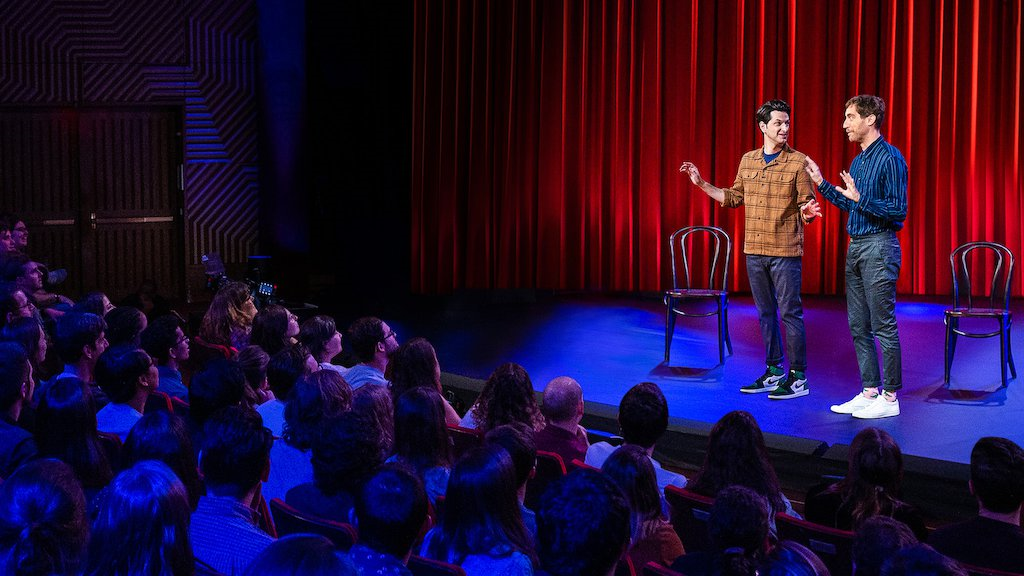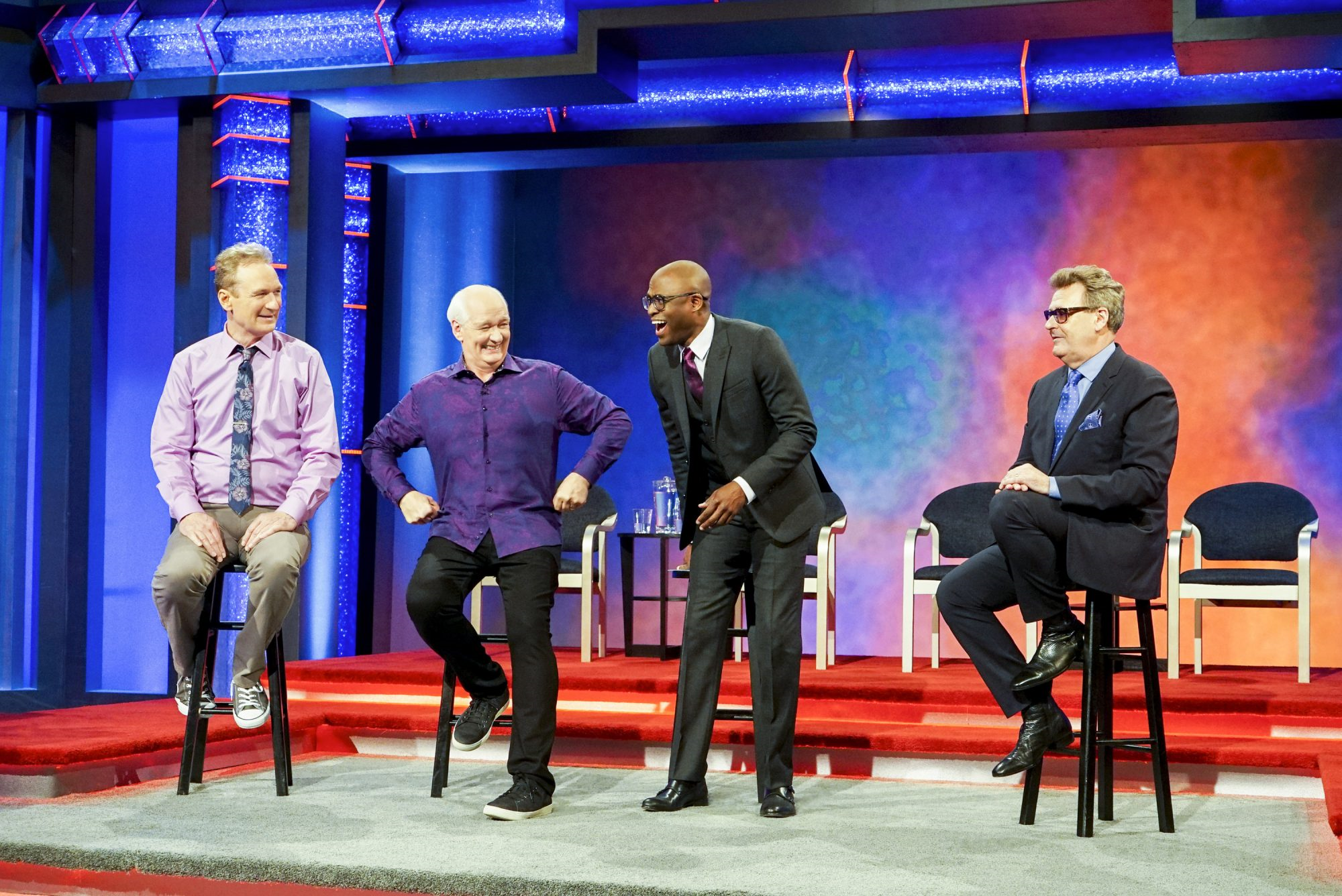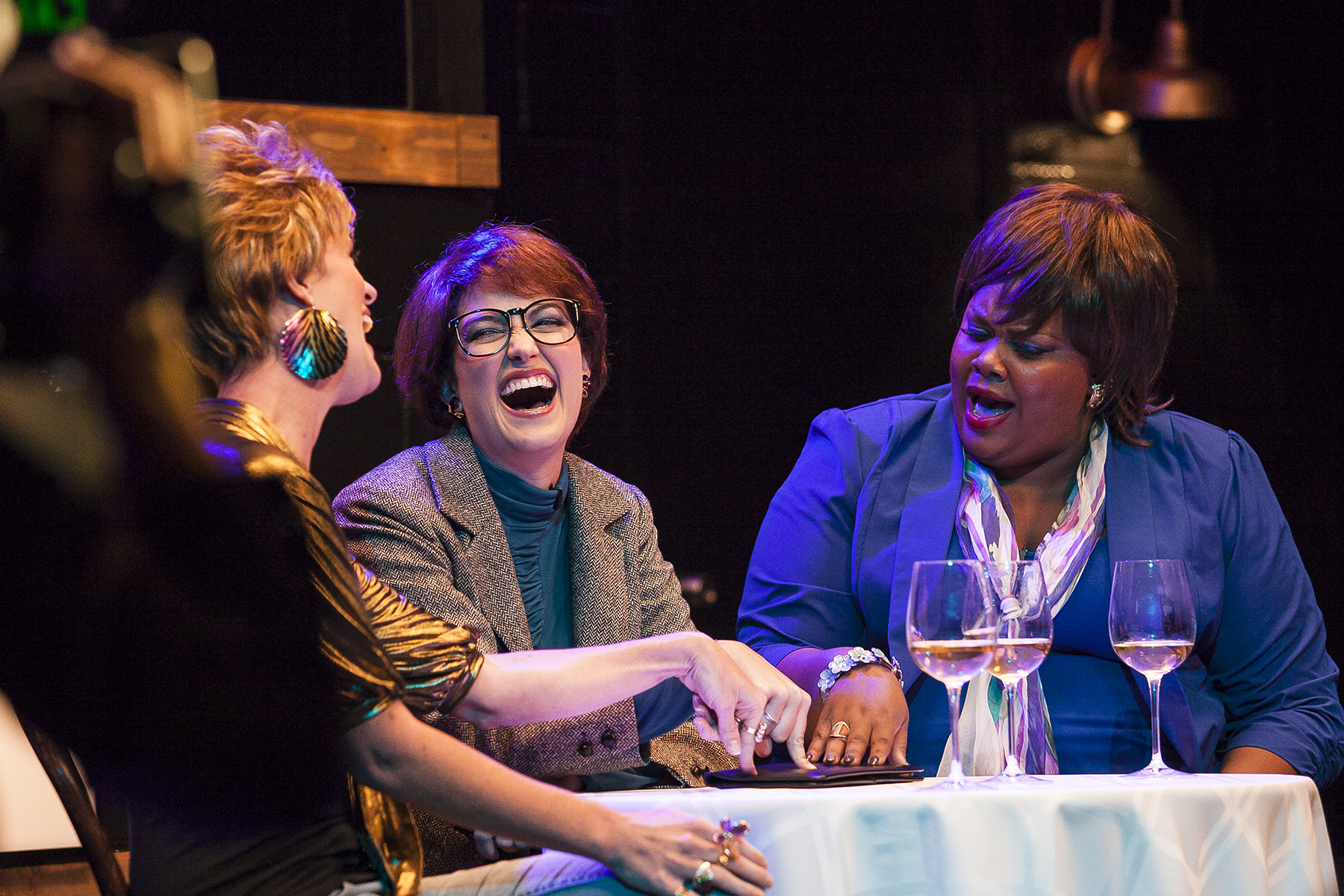“It Could Be About Anything”: Middleditch & Schwartz and the Viability of Televised Improv Comedy
Alex Brannan / University of Texas at Austin

On April 21, 2020, a series of three comedy specials under the name Middleditch & Schwartz was released on Netflix. The comedy show, created and performed by the eponymous comedy pairing of Thomas Middleditch and Ben Schwartz, consists of tapings of theatrically performed long-form improv comedy. This is to say, Middleditch and Schwartz, following a brief discussion with an audience member as a starting point, completely make up an hour-long comedic narrative on the spot. While this may sound unlike any televised comedy special you have ever heard of, improv has enjoyed a lengthy history on- and off-screen. The form stretches back to the 1930s with the acting teaching of Viola Spolin at the Hull House in Chicago (where improv was not necessarily a comedy form, but an exercise in extemporaneous expression for the sake of less inhibited acting).[1] Improv would go on to serve as the backbone for multiple comedy institutions—The Second City, the ImprovOlympic (iO), and the Upright Citizens Brigade (UCB), among others. And while various members of these comedy communities have achieved successful careers in the entertainment business, rarely has long-form improv comedy been translated to film and television.
A show like Whose Line is it Anyway? (Channel 4, 1988-99; ABC, 1998-2004; ABC Family, 2005-07; The CW, 2013-present) televised improv for a mainstream audience, and a few other shows followed suit, albeit often to less success. However, these shows use short-form improv—games with distinct rulesets that exist independent from one another and do not manifest into full narrative scenes. True long-form improv comedy has almost never been televised, the most notable exceptions being two television specials from the UCB, based on one of their most popular live shows, A.S.S.S.S.C.A.T.: Improv (Bravo, 2005) and Upright Citizens Brigade: ASSSSCAT (Comedy Central, 2008), and a comedy special made in conjunction with Showtime’s House of Lies (2012-16) called House of Lies Live (Showtime, 2013), which featured Schwartz and was loosely based on his live show Snowpants.
Seemingly, then, Middleditch & Schwartz marks a step forward in the mainstreaming of long-form improv. But how effective is the show, and its distributor Netflix, at reaching and cultivating a wide audience? Furthermore, what does the show say about the viability and replicability of long-form improv as a television format? I argue that, for as much as the show is effective in its comedy and presented in a cinematic manner, Middleditch & Schwartz is demonstrative of the hurdles that prevent long-form improv from expanding from the live stage to the home. Specifically, the spontaneity of the form itself and the corporate goals of Netflix present potential barriers to entry for long-form improv comedy.

The most obvious defining element of improv is spontaneity. Improv scenes are constructed based on the fundamental principle of thinking on the fly. This is not to say that improv lacks structure—that is far from the truth. Long-form improv, according to the Upright Citizens Brigade Comedy Improvisation Manual, necessitates that performers find “the game” of a scene, which involves searching for an unusual aspect early on in a scene and then heightening by posing the question, “if this unusual thing is true, what is else true?”[2] Students at the UCB learn a variety of different structural formats for long-form improv, such as “The Harold,” in which improvisers construct three seemingly disparate narratives that coalesce at the end of the show.[3] Different improv theaters have their own philosophies on the construction of long-form improv. Nevertheless, all improvisers are taught how to structure scenes logically as they are making them up on the spot. Spontaneity is not attained at the expense of narrative structure.
In this light, it seems feasible to translate long-form improv into an episodic format. However, the act of getting a program like that green-lighted and financed has proven to be a difficult process. Schwartz, describing the pitching process for Middleditch & Schwartz, saw push-back when his answer to what the show would be about was, “We have no idea. It could be about anything.”[4] There is an understandable reticence to financing a show with no script and apparently no guarantee of structural integrity. This could explain why even shows created by institutions known for improv comedy, like SCTV (Global, 1967-79; CBC, 1980-83; Superchannel/Cinemax, 1983-84) and The Upright Citizens Brigade (Comedy Central, 1998-2000), opted for a sketch comedy format. Even The UCB Show (Seeso, 2015-17), which initially ran on an OTT network branded on its appeal to the “comedy nerd” crowd and, thus, would appear as the most conducive arena to market test an episodic long-form improv format, instead structured episodes with a mix of sketch, character-based, and stand-up comedy.

Middleditch & Schwartz has, apparently, broken through that barrier of reticence with the help of Netflix, but the replicability of the show’s format remains up for debate. It is a piece of content that seems to work perfectly within Netflix’s infrastructure. One of Netflix’s primary focuses is engagement—the company highlights the metric of “hours per subscriber per month” as a strong indicator of subscriber retention.[5] Their success, then, is dependent on having a large, diverse library of content, but this library must not necessarily consist of entirely “high quality” content. As Matthew Ball suggests, “Netflix’s scale and technology enables it to launch a mediocre show to a larger audience than most of its competitors can when they produce an outstanding one. That doesn’t mean the company doesn’t want great shows, but it does mean that the risk of producing a disappointing one is much lower.”[6] This is not to speak to the quality of Middleditch & Schwartz, but Ball’s point speaks to the freedom over qualitative risk that Netflix has over its competitors, meaning that Netflix can take a risk on a form largely untested in the visual media marketplace where other companies cannot.
Historically, the mainstream understanding of improv comedy was that it resembled Whose Line is it Anyway?. Co-founder of the UCB, Matt Besser, speaking in 2013, lamented that Whose Line is it Anyway? cemented for a mainstream audience a perception of improv that neglects long-form. “I wish that A.S.S.S.S.C.A.T. or Improv4Humans [Besser’s long-form improv podcast] was on television the way Whose Line is on television,” Besser says. “The truth is that television [executives have] determined that long-form is too slow … it’s not in bite-sized pieces that you can put on television.”[7]
While Middleditch & Schwartz has proven critically successful, Netflix is likely not the venue that is going to prove or enhance the mainstream viability of long-form improv. In an interview with Forbes, Middleditch and Schwartz admit to the increasing visibility yet still niche status of long-form improv. “Improv is a little bit more out there now,” Schwartz says. “The fact that we’re on TV makes it easier [to find an audience] … [b]ut at the beginning of every single show, we explain what [long-form] improv is because we assume the entire audience has not seen it.” To which Middleditch adds, “Only the ‘Yes and…’ nerds.”[8] This acknowledgment of the niche fanbase for long-form improv factors into Netflix’s algorithmic handling of its content. At the special’s launch, Middleditch & Schwartz may have received marquee status on Netflix’s user interface—at the very least, it is sure to have received high visibility on the user interface of users who, according to Netflix’s algorithms, enjoy this brand of irreverent comedy. Since then, as with all Netflix content, the show has disappeared under the weight of the revolving door that is new Netflix releases. Now, the show’s viewership is going to come predominantly from those users who seek it out (i.e. the “yes and… nerd” niche). This is to say that, while Netflix may be the company who took the big swing of financing long-form improv comedy on a large scale, it may also be the exact wrong location for such a project if that project’s goal is to broaden the viewership of improv comedy.
On the flip side, Netflix’s ability to finance Middleditch & Schwartz at high production values and their desire to invest in niche content speaks to the potential for improv as a televised format. Although, the production value poses its own concerns. Middleditch & Schwartz presents long-form improv in a unique way that alters the viewing experience. For one, the ethos of the comedy duo’s show is to bring a form of comedy that is generally only seen in intimate comedy theaters to larger venues. Their touring show has played venues as large as Carnegie Hall, and the Netflix specials were filmed at NYU’s 800-seat Skirball Center for the Performing Arts. As such, Middleditch & Schwartz is not necessarily reflective of the traditional experience of spectating improv. Add to this the cinematic apparatus, and the improv starts to look much different than it has traditionally. Filmed improv brings with it the complication of needing to make creative decisions in post-production (e.g. edits that truncate or remove scenes) which alter and disrupt the spontaneity of the comedy. Conversely, something that is less cinematic, such as a single-camera format filmed from an audience perspective without any edits, may preserve the integrity of the comedic event, but it would likely not be as marketable as something like Middleditch & Schwartz, which comes off visually similar to a well-produced stand-up special.
Middleditch & Schwartz is, in my opinion, a well-made and effectively humorous series of specials, and the two comedians are re-imagining the possibilities for long-form improv comedy in intriguing ways. It is Netflix’s platform, which exploits the niche appeal in content like Middleditch & Schwartz, which allows for this experimentation to exist where it could not before. That said, the replicability of Middleditch and Schwartz’s format is up for debate, and Netflix’s infrastructure does not seem conducive to increasing mainstream visibility for long-form improv. This is the sort of double-edged sword that helps define the current media landscape: When everything under the sun is made available to the consumer, how can anything truly become popular?
Image Credits:
- Netflix’s Middleditch & Schwartz marks one of the few times that long-form improv comedy has been filmed for television. (author’s screen grab)
- Whose Line is it Anyway?, arguably the most popular improv comedy program, differs from Middleditch & Schwartz in that it employs short-form games rather than full narrative scenes.
- The UCB Show, which originally aired on Seeso, showcases sketches, character-based comedy, and stand-up comedy from the theater’s top talent.
- Matt Besser’s Improv4Humans, a podcast on the Earwolf network, has produced a small number of video episodes. Besser has spoken out in the past about the desire to see long-form improv on television.
- Wasson, Sam. Improv Nation: How We Made a Great American Art. Houghton Mifflin Harcourt, 2017, 3-8. [↩]
- Allen, Emma. “How the Upright Citizens Brigade Improvised a Comedy Empire.” The New Yorker, 29 August 2016, https://www.newyorker.com/magazine/2016/09/05/upright-citizens-brigades-comedy-empire. [↩]
- Besser, Matt, et al. The UCB Comedy Improvisation Manual. Comedy Council of Nicea LLC, 2013, 275-317. [↩]
- Fox, Jesse David. “What if Improv Were Good?” Vulture, 24 April 2020, https://www.vulture.com/2020/04/middleditch-schwartz-netflix-comedy-specials.html. [↩]
- Ball, Matthew. “Netflix is a Product & Technology Company (Netflix Misunderstandings, Pt. 2).” Redef, 12 May 2018, https://redef.com/original/netflix-misunderstandings-pt-2-netflix-is-a-product-technology-company. [↩]
- Ibid. [↩]
- “Bonus Episode: Ask the UCB 3.” Improv4Humans from Earwolf, 24 September 2013, https://www.earwolf.com/episode/bonus-ask-the-ucb-3/. [↩]
- Ross, Danny. “The ‘Meteoric Rise’ of Middleditch and Schwartz.” Forbes, 26 February 2019, https://www.forbes.com/sites/dannyross1/2019/02/26/the-meteoric-rise-of-middleditch-schwartz/#3b7557e788c1. [↩]